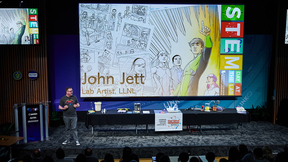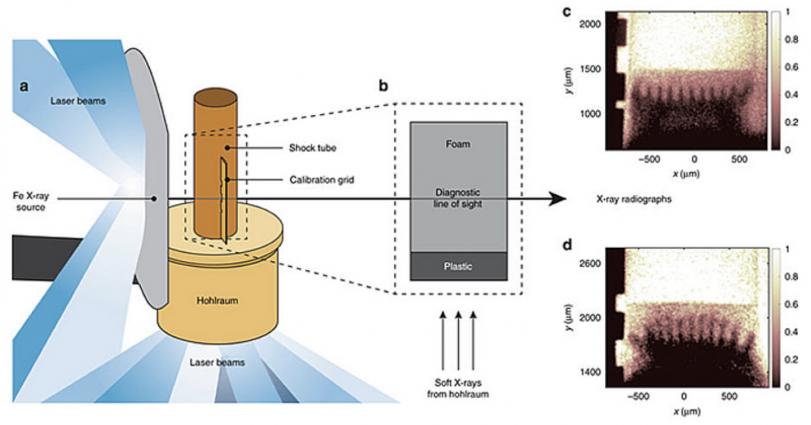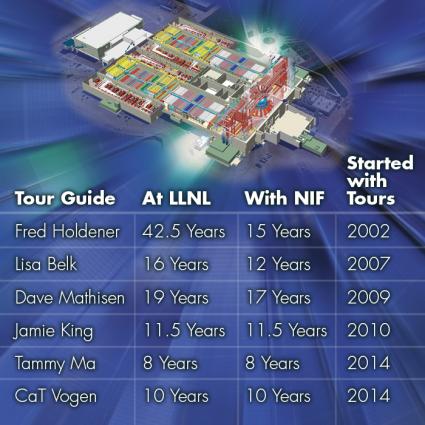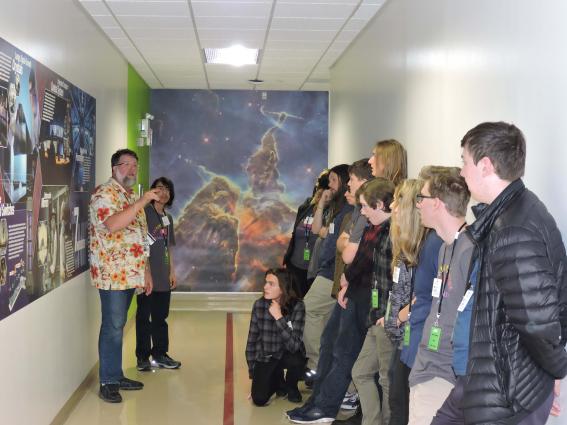Tour guides put NIF's best foot forward
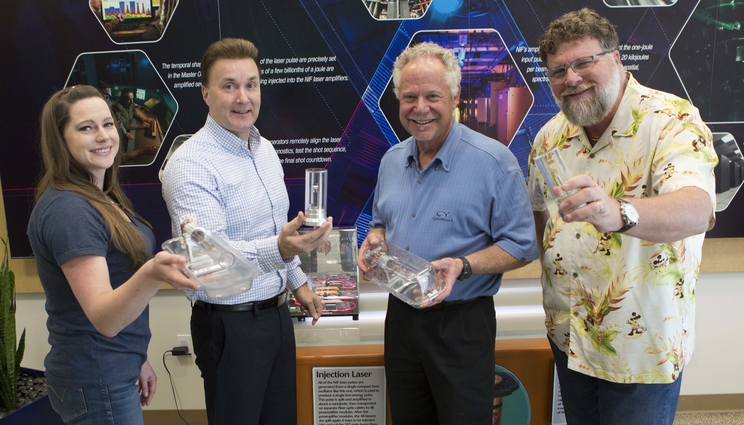 (Download Image)
Tour coordinator CaT Vogen and tour guides (from left) Jamie King, Fred Holdener and Dave Mathisen show off the targets they use at the start of each tour. Credit: Jason Laurea
(Download Image)
Tour coordinator CaT Vogen and tour guides (from left) Jamie King, Fred Holdener and Dave Mathisen show off the targets they use at the start of each tour. Credit: Jason Laurea
In 2017, after more than eight years of operation, the National Ignition Facility (NIF) at Lawrence Livermore National Laboratory (LLNL) reached its epic 2,000th shot. Over that time, as the shot rate steadily climbed, other important numbers also have risen dramatically. By the end of 2017, the total number of people exposed first-hand to NIF’s world-class technology and achievements by participating in official facility tours grew to 82,336. Due to a boost from Family Day last October, 12,348 of those visitors were from last year alone.
These visits were made possible by the work of dozens of NIF volunteer tour guides, who take time out from their busy schedules to spread the word about NIF’s science and missions.
"NIF is an incredible facility that demonstrates what the Lab, NNSA (the National Nuclear Security Administration) and the nation are capable of achieving for our national security through dedication and hard work," NIF Director Mark Herrmann said. "Educating others about this amazing capability is both a lot of fun and an important responsibility. I’d like to thank the tour program and all the dedicated tour guides for all their hard work in sharing NIF with visitors to the Lab."
A group of veteran tour guides responsible for introducing many visitors to NIF recently took a few moments to reflect on the tours they’ve led over the years:
"I started giving tours in 2002, before the laser was even built," says Fred Holdener, a senior mechanical design engineer. "Once the building was up, we took people onto the roof and showed them the windmills on the Altamont Pass because there wasn’t much else to see yet. Then we’d take them to the four-story loft to see the giant blowers, which eventually would cool the amplifiers. That’s how early I started."
Nowadays tours, like NIF, are finely tuned machines unto themselves. And if NIF is between shots, visitors are treated to a glimpse of the Target Bay, where inside a vacuum chamber NIF’s 192 lasers deposit up to nearly two million joules of ultraviolet energy on a tiny target, creating conditions comparable to the cores of stars and giant planets.
Official tours became formalized in 2003 and up to the end of last year’, have been run no fewer than 7,403 times. Though the age range of tour visitors is wide, having the opportunity to reach students of all ages is a tour-guide favorite.
"I ask the students about what careers they think are needed to run NIF," said NIF Computation Division Leader Lisa Belk. "We have conversations about the different professions, then tie them to the different college degrees. It is quite eye-opening to them. We talk about physicists, engineering, computer science, business, finance, marketing, graphics design and more. They learn how a variety of jobs must come together in an interdisciplinary way to create a great scientific research and development facility."
For now and for our future, say the tour guides, it’s more important than ever to recognize diversity and better connect the full range of students to science. The Laboratory strives to achieve this outreach through programs like Expanding Your Horizons and Science on Screen. NIF tours also play an important role, but there are only five female tour guides.
"We need more women to join the tour-guide ranks," Belk said. "Especially when giving tours to middle, high school or college students, people often come up to me to say that they were happy to see a female scientist. It is important for young women as well as young men to see the Laboratory representing this and other types of diversity."
NIF isn’t just the largest laser in the world, standing off on its own. It connects to all of LLNL’s directorates and embodies the full range of work performed across the Laboratory. Tour guides translate this integration as they explain what the Laboratory does in the broader context of national security and stockpile stewardship. And being inside an enormous laser is a straightforward way to resonate with visitors.
"Working as a tour guide reminds me that, from the very start, NIF is made up of people who devoted their lives to achieve ignition at the Laboratory," said computer scientist Dave Mathisen. "I have so much respect for them. Now it has become my life’s work and my passion to carry on the legacy. It’s just so cool when we get to show the public what we do. Everybody, including me, turns into a 12-year-old kid and goes, ‘Wow.’"
Jamie King, the Laboratory’s Laser Safety Program manager and NIF’s laser safety officer, adds that sharing with the public is vital for NIF’s longevity. Knowing that most visitors will likely only get to see the hour-long tour once, he aims to show off how well the nation’s investment in NIF is paying off.
"It’s great the way the public lights up," King said. "Our duty as tour guides is to blow them away with the science, which isn’t hard to do considering the amazing things that go on here. We want to leave them inspired and feeling a sense of awe. This also helps them to understand how well their tax dollars are being spent."
The Target Bay, Laser Bay overlook and Control Room are, of course, impressive stops for visitors. But connecting to NIF’s operations in relatable ways also has a tremendous impact.
"I love telling mind-blowing facts, like every time we do a shot at NIF, we are one of the hottest places in the solar system," said experimental plasma physicist Tammy Ma (NIF implosions reach peak temperatures of more than 100 million degrees Centigrade -- more than five times hotter than the core of the Sun). "When their eyes bulge, I find that incredibly gratifying."
The science outreach at the Laboratory, which Ma is part of now, had a direct influence on her many years ago.
"I heard a Science on Saturday talk about NIF by (former NIF Director) Ed Moses when I was a student. I went to a lot of these talks," Ma said. "And later when I was a summer intern at the Laboratory, I got a NIF tour. The walls weren’t even up yet, and of course at the time, I had no idea what was going on. But now, I’m part of both programs, and I get to expose people to big science -- it’s really cool."
Tours are limited to 15 visitors and are held on average of about 10 tours a week. For some busy weeks, the number of tours surpasses 20, so there’s a high demand for tour guides and a need to orchestrate the flux of visitors within NIF without interrupting its operations.
"Understanding the interests, background and needs of a visitor group is also important," said NIF tour program coordinator CaT Vogen. "All the tour guides cover the same messages about NIF’s missions and how the laser functions end-to-end, but each of them brings unique specialties, approaches and experiences. I try to match them up to give the visitors the best experience possible."
Sixty employees are currently certified to conduct tours and 15 more are in training. Volunteers must complete two web courses and "shadow" a few tours to become certified. Those interested in becoming a tour guide should contact vogen3 [at] llnl.gov (Vogen).
NIF tours are clearly a win all the way around. The Laboratory has the opportunity to open a window into its vital missions and cutting-edge science; the public gets an up-close view of the inner workings of a world-leading research facility; and tour guides continue to make this connection possible, as NIF persists in pushing the boundaries of science.
-Dan Linehan
Contact
 Breanna Bishop
Breanna Bishop
[email protected]
(925) 423-9802
Related Links
National Ignition Facility & Photon ScienceTags
National Ignition Facility and Photon ScienceNational Ignition Facility
Lasers and Optical S&T
Lasers
Featured Articles
